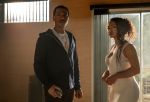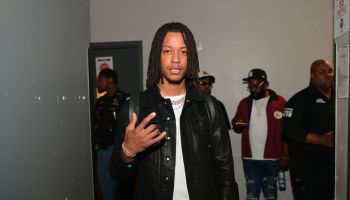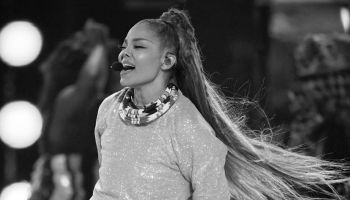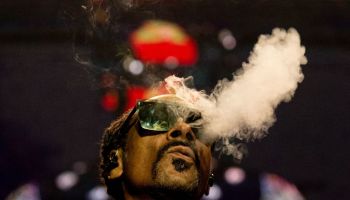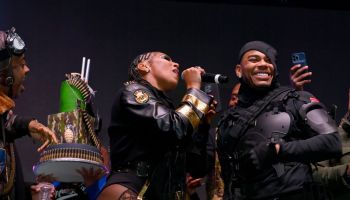Brooklyn based, NYC educated photographer Rayon Richards has come a long way since art school.
While his classmates were racking up darkroom hours at SVA, Richards, now 29, was out knocking down the doors of photo editors at some of the hippest and noted magazines in New York, getting assignments and being written about in the process.
We know because we’ve seen him in action, grinding since the late 1990s and early 2Ks.
These days, Richards is a successful photographer whose clients include Footlocker, Jive, Complex, Fast Company, Coors Brewing Company, Clear Channel, XXL and Maxim, to list a few.
We spoke to Richards, who discovered photography thanks to a family trip to Jamaica when he was in his teens, and who was mentored by photographer Ernie Paniciolli, several weeks ago. Check out our exclusive below!
GlobalGrind: What’s going on with Rayon Richards?
Rayon Richards: I’m really good man, can’t complain! Work is great, a lot of growth taking place. I’ve been sitting here for the past week, editing and updating my website, trying to figure out what should stay and what should go. Over time, the work evolves and there are just some images that no longer fit in with the overall feel.
[pagebreak]
I’ve known you for almost 10 years, since 2001 when you were at SVA. What was going through your mind back then when you were getting attention for your photography and you were still a student?
I was so excited about the prospects of being a professional photographer. I remember being in the darkroom freshman year thinking that success was so far away. With supportive and encouraging people like you around me, I was fortunate enough to start my career
right after freshman year. I remember meeting with you on multiple occasions with my black & white 8×10 portfolio. I remember you saying, ‘This black & white stuff is good but if you really want to compete or have your work noticed you have to shoot color.’ That prompted me to start shooting in color even though it had not yet been introduced into my curriculum at School of Visual Arts. I taught myself to print color, while my peers were still in the black and white darkroom. I always had drive to be better; I did whatever I had to do to figure it out. Before long, I was shooting for magazines like The Source and Fortune. I would show up to my critique class with published photographs of rappers and rock musicians or corporate executives while my classmates were photographing their friends.
Can you recall your first introduction to photography and what made you decide you wanted to be a photographer?
It all began in the summer of 1996 on a family trip to Jamaica. It had been a full 10 years since I had been there prior but so much had changed in that space of time that I just wanted to photograph everything. I wanted to be sure that if another 10 years passed before I made it back, at least I had memories of those experiences recorded. Three years later in ’99, while taking a photography class at my school, LaGuardia High School of Music & Art, I met my mentor Ernie Paniciolli. He invited me to his studio and I became his assistant soon after. Hanging around with him, seeing how he interacted with his subjects and what it took to create his images; going to parties, and being in the offices of various magazines as well as being in the studio with him after school is what really made me say, ‘Wow! I wanna be a professional photographer!’
I truly enjoyed all of the elements that came together; the performance of the subject versus the performance of the photographer, the collaboration with the glam squad, the teamwork, all of this effort for an image that documented a moment in time; to me it was the greatest thing ever and all I wanted to do.
[pagebreak]
Who are some of the high profile folks you’ve shot?
Over the years, I’ve been blessed to have had many great experiences photographing some of the most talented and amazing people in entertainment and media; legends as well as people who are fairly new in their careers. I’ve photographed BB King, The Edge from U2, Diddy, DJ Khaled, Peter Frampton, Terrence Howard, Moby, Soledad O’Brien, Wendy Williams, Ludacris, Amber Rose, Pharrell Williams, Buddy Guy, John McEnroe, Gabrielle Anwar, Tom Colicchio, & Snooki just to name a few.
Do you ever get starstruck?
As unbelievable as this may sound, I don’t really get starstruck. I become so focused on my goals for the shoot in trying to create the best image of this person that I possibly can. Getting caught up in hype is a distraction. My goal is to create an atmosphere that will allow a celebrity to feel like they can just be human. When you behave like a fan, you lose their respect. I treat celebrities as equals. Creating images that look like I truly shared a genuine moment with someone is my number one priority. You can’t hide sincerity from the camera but you also can’t hide discomfort. The viewer can sense it, so it’s important that good vibes translate from me to the subject, to the camera to the image to the viewer.
[pagebreak]
What challenges have you found with shooting men versus women?
Well, I don’t think I’d refer to the differences in photographing men vs women as challenges but rather completely separate approaches. It’s really no different from normal person-to-person interaction except that I’m holding a camera when I’m engaging the subject. The way I’d approach a woman in conversation and the things I’d talk about are generally different from the subjects I’d bring up with men, but its actually less about gender and more about trying to get a good sense of what the person is all about; what they’re into; what kind of mood they’re in and using that to my advantage.
What advice would you give to emerging photographers?
In addition to telling young photographers to make sure that they’re always shooting and trying to be better, I’d tell them to be 2 things:
– observant – pay attention to everything going on in the world around you.
– absorbent – be like a sponge and soak up all you can
These two qualities will not only inform your work but they’ll make you invaluable. Conversation and interaction are major parts of what it takes to produce a great portrait. A lot of people get caught up in lighting, expensive cameras and megapixels but at the end of the day, what makes a good image is strong content and the human element.







